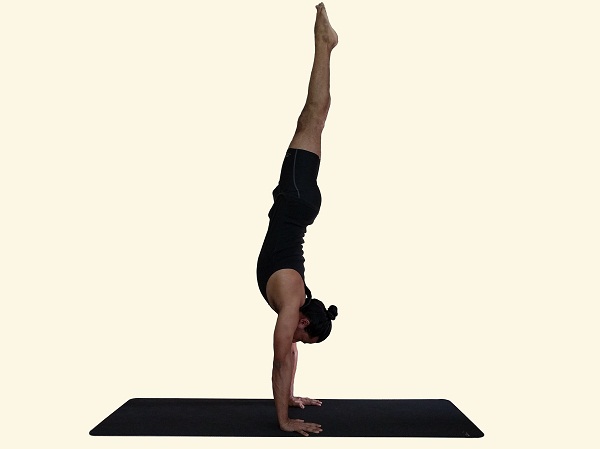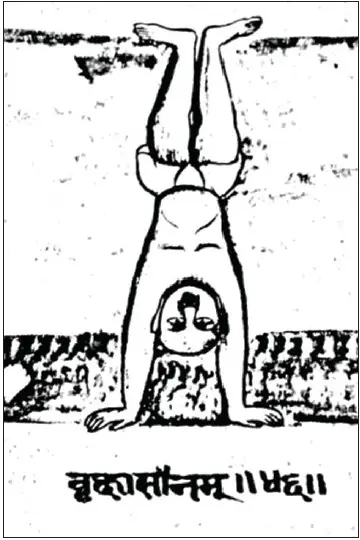Adho means downward, mukha means face and vriksh means tree. This posture is mentioned in an ancient unpublished manuscript “Yogāsana – Jaina” as Vṛkṣāsana. This manuscript is a very modern text, not older than 200-250 years (the exact date is not yet known). This manuscript was procured from Rajasthan Prachya Vidya Pratishthana, Bikaner, Rajasthan, a copy of which is available at Kaivalyadhama Library. Check out the link for more details on the research work going on for the same. Given below is the illustration from the same manuscript.
Excerpts from the research work
“The illustration provided in the current manuscript suggests it to be a hand-stand, i.e. keeping the whole body straight in a topsy-turvy position and balancing the whole body on both the palms with straight hands. This hand-stand variation of Vṛkṣāsana is very different from the popularly known variation available in Gheraṇḍasaṃhitā (Digambar & Gharote, 1978, Ch. II / 36), where it has been described as an āsana of standing on one leg with one heel placed at the thigh joint.”
The major obstacle to handstand is the fear of falling, you can practice it against a wall till you get the confidence to try a free handstand.

Steps:
- Stand in Tadasana. Bend forward and place the palms on the floor shoulder width apart about a foot away from the wall. Keep the arm fully stretched.
- Bring the legs back, bend your right foot forward coming in a runners stance (you can also bring the left foor forward if thats your dominant leg). Suck in your lower abs.
- Inhale, press the bent leg on to the floor and swing the legs up against the wall (remember not to put the hands very far from the wall, it will make your back arch more and then it might be difficult to balance). Keep your head up, straighten your legs and point your toes, keep your abdominal muscles sucked in, thighs and hip muscles tight and the hands completely straight. Stay in the posture for a few seconds and then gradually increasing the time.
- After a few weeks of practice try to take your feet away from the wall and balance. After you gain more confidence and strength try a free handstand in the middle of the room with a partner standing near to support you and stop the fall.
Benefits:
- Strengthens the shoulders, arms, and wrists
- Stretches the belly and the chest.
- Improves sense of balance
- Calms the brain and helps relieve stress and mild depression
Contraindications:
- Back, shoulder, or neck injury
- Headache,Heart condition,High blood pressure
- Menstruation
